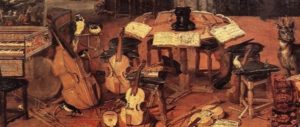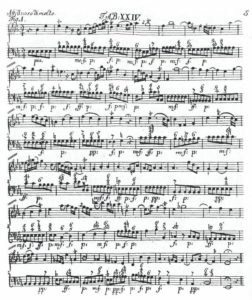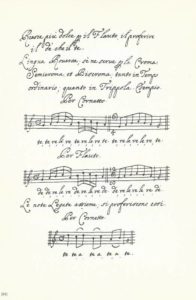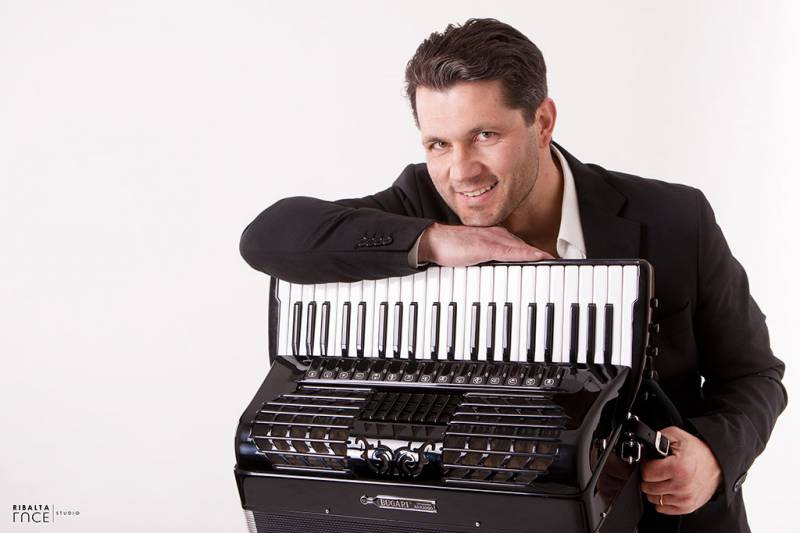Giorgio Dellarole: musica antica per uno strumento moderno – 4 (English version of this article)
TESI E ARSI
 Con il quarto articolo, dopo aver trattato delle fonti d’informazione sul repertorio sei-settecentesco, inizio ad addentrarmi nelle questioni fondamentali riguardanti l’interpretazione, a partire dalle problematiche legate all’articolazione.
Con il quarto articolo, dopo aver trattato delle fonti d’informazione sul repertorio sei-settecentesco, inizio ad addentrarmi nelle questioni fondamentali riguardanti l’interpretazione, a partire dalle problematiche legate all’articolazione.
Possiamo definire l’articolazione il modo in cui i suoni di un brano sono concatenati fra loro tramite micro silenzi finalizzati a dare una particolare evidenza alle singole note. La scarsità di indicazioni che caratterizza le composizioni barocche non sottintende che l’esecuzione debba essere semplicemente ed uniformemente legata o slegata, ma richiede all’interprete moderno uno sforzo supplementare per la comprensione dei brani e per la ricerca di un’interpretazione che non comprometta la varietà, cifra essenziale dell’estetica barocca.
La fisarmonica, nata da poco più di un secolo, soffre particolarmente di questa carenza poiché, trattandosi di uno strumento che esegue brani concepiti per altri strumenti, non possiede caratteristiche tecniche o meccaniche che supportino determinate scelte interpretative.[1]
Il riferimento principale per il nostro strumento è sicuramente l’organo, che ha la possibilità, come la fisarmonica e al contrario di clavicembalo, clavicordo e fortepiano, di prolungare i suoni. A differenza dell’organo la fisarmonica possiede un mantice dinamico che, però, non le permette di dettagliare i piccoli fraseggi e quindi la gestione dell’articolazione può essere normalmente ispirata a quella degli organisti.
Anche in questo caso, come nell’ambito dei principi generali dei quali ho scritto nei primi tre articoli, è importante che l’esecutore possieda le informazioni teoriche necessarie[2] e, per quanto riguarda l’articolazione, è fondamentale la conoscenza delle modalità accentuative caratteristiche del repertorio sei-settecentesco.
Penso che il punto di partenza possa essere il riconoscimento, nella struttura melodica e armonica del brano che si affronta, dei momenti di “tesi” e di “arsi”, intesi non, o non solo, come situazioni di “più forte” e “meno forte”, ma come stati di “peso” maggiore e di “peso” minore, di appoggio e di alleggerimento, di battere e levare.
Per quanto riguarda il flusso orizzontale (la linea melodica) si potrebbe iniziare con l’analisi dei valori più brevi del brano per proseguire con quelli più ampi e con le frasi e i periodi musicali. Luca Oberti[3] fa un interessante paragone, che ritengo illuminante, tra il linguaggio dell’elettronica, basato su successioni di “0” e di “1” e la musica barocca, che definisce “musica binaria multilivello”.
 La stessa ricerca andrebbe condotta a livello di struttura verticale (armonica) facendosi magari guidare da J.J. Quantz e C.Ph.E. Bach[4] che trattano ampiamente la materia partendo dalla coincidenza tra dissonanza e momento di “appoggio” e tra consonanza e momento di “levare” e sviluppano poi le numerose eccezioni alla regola (armonie modulanti, salti verso tonalità lontane…). Osserviamo che Quantz in particolare suggerisce di definire la dinamica di una composizione in base alla sua struttura armonica[5].
La stessa ricerca andrebbe condotta a livello di struttura verticale (armonica) facendosi magari guidare da J.J. Quantz e C.Ph.E. Bach[4] che trattano ampiamente la materia partendo dalla coincidenza tra dissonanza e momento di “appoggio” e tra consonanza e momento di “levare” e sviluppano poi le numerose eccezioni alla regola (armonie modulanti, salti verso tonalità lontane…). Osserviamo che Quantz in particolare suggerisce di definire la dinamica di una composizione in base alla sua struttura armonica[5].
La conseguenza immediata dell’applicazione di questa idea alla conduzione del fraseggio, anche in assenza di una particolare consapevolezza interpretativa, è la rottura della monotonia che troppo spesso affligge le esecuzione attuali del repertorio antico, figlie della tendenza moderna verso linearità e velocità.
Realizzare che il discorso musicale può procedere con una “naturale”[6] ondulazione, oltre ad agevolare notevolmente la tecnica strumentale, sblocca l’esecuzione stessa e la rende umana, viva.
I concetti di “tesi” e “arsi” hanno radici antiche e costituiscono i fondamenti della poetica greca e latina. Il fatto che la teoria greca collochi l’appoggio sulla “tesi” e quella latina consideri l’”arsi” il momento di elevazione sul quale far cadere l’accento non inficia il gioco di alternanza nella densità sonora che rappresenta il fulcro della questione.
La prassi musicale è da sempre influenzata dalla metrica poetica. Lo è, naturalmente, nella cultura greco-romana, lo è nel Medioevo con la scrittura neumatica che identifica come ditiones le sequenze di piedi metrici basate sull’alternanza di sillabe lunghe e brevi e lo è ancora con Caccini agli albori del moderno melodramma.
La musica strumentale, che è il nostro principale argomento di indagine, è al principio strettamente legata alla vocalità (quando non completamente “al servizio” della vocalità o della danza) e quindi ci si basa sulla scansione della parola per determinare l’accentuazione e l’articolazione del fraseggio.
Nel Rinascimento inizia il lungo processo di emancipazione degli strumenti che acquisiscono poco alla volta quelle caratteristiche meccaniche e sonore che li renderanno autonomi e i trattatisti italiani traducono il concetto binario basato sulla contrapposizione tra sillabe lunghe e brevi con l’alternanza tra “note buone” e “note cattive”, cioè tra note portatrici di accento tonico e note non accentate o meno accentate.
Per quanto riguarda la tastiera si teorizza la corrispondenza tra maggiore e minor “peso” delle note consecutive e maggiore o minor “forza” delle singole dita. Ad esempio: terzo dito – maggior peso (dito “buono” su nota “buona”); quarto dito – minor peso (dito “cattivo” su nota “cattiva”).
Non sempre i trattatisti concordano su quali siano le dita “buone” e quelle “cattive”[7], ma resta l’idea di fondo dell’alternanza tra momenti di “tesi” e momenti di “arsi”.
 Per gli altri strumenti abbiamo le direzioni dell’arco del violino rappresentate da “her” (giù) e “hin” (su) descritte da Leopold Mozart[8], il “te-re”-“le-re” del cornetto e il “de-re”-“le-re” del flauto proposti dal Bismantova[9] o ancora il “ti-ri” del flauto di Quantz[10].
Per gli altri strumenti abbiamo le direzioni dell’arco del violino rappresentate da “her” (giù) e “hin” (su) descritte da Leopold Mozart[8], il “te-re”-“le-re” del cornetto e il “de-re”-“le-re” del flauto proposti dal Bismantova[9] o ancora il “ti-ri” del flauto di Quantz[10].
A proposito delle diteggiature storiche il mio suggerimento è di documentarsi sull’argomento[11] e di tentare, quando possibile, di applicarle anche alla fisarmonica, sia allo strumento a tasti, sia a quello con i bottoni, sia al manuale destro, sia a quello dei bassi. Nel corso della mia attività didattica ho potuto osservare che anche quella che viene abitualmente (ed erroneamente) definita “fisarmonica cromatica” in alcune situazioni sembra paradossalmente predisposta all’uso delle diteggiature antiche.
Lo sforzo supplementare richiesto all’esecutore è, a mio parere, ampiamente compensato dall’emergere quasi naturale delle peculiarità espressive dei fraseggi e degli ornamenti.
Se viene accettata l’idea di una struttura musicale basata su momenti di “tesi” e di “arsi” e vengono applicate, quando possibile, delle diteggiature adeguate il problema che si pone è quello di individuare con chiarezza questi momenti.
Dal prossimo articolo tratterò in maniera specifica e pratica dell’articolazione: dove articolare, perché farlo e in che modo, cosa implica il segno di legatura, come trattare gli ornamenti…
Concludo segnalando un paio di novità che riguardano la mia attività didattica.[12] La prima è l’apertura di un Biennio orientato all’approfondimento del repertorio antico che dal prossimo Anno Accademico sarà attivo presso il Conservatorio “A. Boito” di Parma. A fianco del Biennio che possiamo definire “tradizionale”, all’interno del quale lascerò una certa libertà allo studente nella scelta del repertorio da approfondire, ho abbozzato un Biennio nel quale si lavorerà nel dettaglio sulla musica sei-settecentesca e nel corso del quale, in forme e modi da definire, si collaborerà con il Dipartimento di Musica Antica del Conservatorio. Il link per la visione del programma e della sua struttura è il seguente:
La seconda novità riguarda una masterclass che terrò tra la fine di luglio e l’inizio di agosto a Sale San Giovanni (CN), durante la quale tratterò ampiamente le tematiche che ho proposto nei miei articoli. Le informazioni sono reperibili al seguente indirizzo:
http://www.corsiarion.it/programmazione.21.html#/Materialeillustrativo
[1] Gli strumenti storici spesso “suggeriscono” all’esecutore articolazioni, dinamiche, espressività.. Pensiamo all’arco corto del violino o alla particolarissima sensibilità della tastiera del clavicordo, che escludono automaticamente tutta una serie di scelte interpretative possibili invece sugli strumenti moderni. Per quanto riguarda la fisarmonica faccio un esempio, tra i tanti, per chiarire ulteriormente la mia affermazione: su una tastiera orizzontale come quella del cembalo o dell’organo, un salto di più ottave implica una distanza di decine di centimetri, che suggerisce automaticamente all’esecutore un respiro e una cesura; sul manuale sinistro della fisarmonica si può risolvere un salto di quattro ottave con una distanza inferiore al centimetro e quindi bisognerà fare uno sforzo supplementare per comprendere la valenza espressiva della scrittura ed esprimerla adeguatamente [2] Non si tratta della conoscenza della teoria fine a se stessa, ma del possesso di una sufficiente familiarità con il contesto storico e stilistico oggetto di studio [3] Definito “uno dei musicisti più interessanti dell’ultima generazione di barocchisti”, Luca Oberti è clavicembalista, organista e continuista. Consiglio qualche ascolto dal suo canale su SoundCloud https://soundcloud.com/lucaoberti [4] Per i riferimenti bibliografici vedere il terzo articolo [5] Nella Sezione VI del XVII capitolo del suo trattato Quantz, parlando dei doveri del buon accompagnatore alla tastiera, analizza e classifica le dissonanze, dividendole addirittura in tre classi e struttura dinamicamente nel dettaglio un piccolo brano in base alle tensioni armoniche. Suggerisco di consultare, sull’argomento, anche il Paragrafo 29 - Terzo Capitolo del Volume del trattato di C.Ph.E. Bach dedicato all’interpretazione [6] “Naturale” inteso sia nel senso di “facente parte della natura umana”, sia nel senso di concetto che permea tutti gli eventi naturali: il moto delle onde (da quelle marine a quelle sonore), il respiro, la dinamica dei movimenti degli esseri viventi che si basa su appoggi e sospensioni, l’alternanza giorno-notte… [7] Normalmente si considera “forte” il dito “medio” che si alterna al secondo e al quarto considerati deboli, anche se Girolamo Diruta (1554-dopo il 1610) ne “Il Transilvano” (Venezia 1625) definisce dita “buone” l’indice e l’anulare e dita “cattive” il pollice, il medio e il mignolo [8] Versuch einer gründlichen Violinschule (1756) – Quarto capitolo [9] Compendio Musicale (1677) – Pag. 93 [10] Versuch einer Anweisung die Flöte traversière zu spielen (1752) – Capitolo VI/Sezioni I-II-III [11] Consiglio la consultazione de Il clavicembalo – Bellasich/Fadini/Granziera/Leschiutta – EDT (la Parte Quarta è interamente dedicata alle diteggiature storiche dal Rinascimento al Settecento) e del libro di Claudia Pilla: Le antiche diteggiature negli strumenti a tasto – Edizioni Armellin Musica – Padova, che raccoglie e ordina con chiarezza molte testimonianze relative ai si secoli XVI e XVII [12] Vorrei anche fare un ringraziamento particolare ad Emilia Fadini (che ho già citato perché con Marco Farolfi e con Luca Oberti è responsabile della mia formazione sul repertorio antico) che all’accentuazione ha dedicato una delle sue ultime “fatiche” letterarie dalla quale sono tratte buona parte delle informazioni e degli spunti che questo articolo contiene. Si tratta di: Emilia Fadini-Maria Antonietta Cancellaro: L’accentuazione in musica. Metrica classica e norme sette-ottocentesche – Ed. Rugginenti
Giorgio Dellarole: early music for a modern instrument – 4
THESIS AND ARSIS
 In my previous articles I spoke about the sources of information on the repertoire of the seventeenth and eighteenth century; in this fourth one I will deal with the fundamental questions concerning the interpretation, starting from some issues related to the articulation.
In my previous articles I spoke about the sources of information on the repertoire of the seventeenth and eighteenth century; in this fourth one I will deal with the fundamental questions concerning the interpretation, starting from some issues related to the articulation.
We can define the articulation as the way in which the sounds of a score are chained together via micro silences intended to give a particular highlight to each individual note.Baroque compositions are characterized by the scarcity of directions, but this does not imply that the execution should be simply and uniformly “legato” or not “legato”; on the contrary, it requires that the modern performer makes some extra efforts in order to have a better understanding of the scores and to search for an interpretation that does not compromise variety, which is essential for the Baroque aesthetics.
The accordion, born a little over a century ago, suffers particularly from this deficiency because it is an instrument that performs pieces written for other instruments; because of this it does not have some technical or mechanical characteristics that can support some specific interpretive choices.[1]
The main reference for our instrument is definitely the organ, which, as the accordion, has the opportunity to sustain notes; thing that is not possible with a harpsichord, a clavichord or a fortepiano. Unlike the organ, the accordion has a dynamic bellows, however, this does not allow to detail little phrases and because of this the management of the articulation is normally based on the same one used by the organists.
Also in this case, it is important that the performer has a thorough knowledge of the theoretical informations[2] and about articulation, it is fundamental to know the typical characteristics of accentuation in the repertoire of the seventeenth and eighteenth century.
I think that the starting point may be the recognition, in the melodic and harmonic structure of the piece that we perform, of the moments of “thesis” and “arsis”, intended not, or not only, as situations of “forte” and “piano”, but as states of greater or minor “weight “, of accented and unaccented, of strong beat and weak beat.
Regarding the horizontal flow (the melodic line), it is possible to start with the analysis of the shorter values of the piece and then to continue with the widest ones and with the musical phrases and periods. Luca Oberti[3] makes an interesting comparison, which I think is illuminating, between the language of electronics, based on sequences of “0” and “1” and Baroque music, which he defines as “multilevel binary music”.
 The same research should be conducted in respect of the vertical structure (harmonic), perhaps under J.J. Quantz and C.Ph.E. Bach’s[4] guidance. Indeed, they deal extensively with this matter, starting from the coincidence between dissonance and strong beat and between consonance and weak beat. Then, they develop many exceptions to the rule (modulating harmonies, distant tones…). We can observe that Quantz suggests to structure the dynamics of a composition according to the harmonic structure[5].
The same research should be conducted in respect of the vertical structure (harmonic), perhaps under J.J. Quantz and C.Ph.E. Bach’s[4] guidance. Indeed, they deal extensively with this matter, starting from the coincidence between dissonance and strong beat and between consonance and weak beat. Then, they develop many exceptions to the rule (modulating harmonies, distant tones…). We can observe that Quantz suggests to structure the dynamics of a composition according to the harmonic structure[5].
The immediate consequence of the application of this idea to the phrasing management, even in the absence of a particular interpretative awareness, is the breaking of the monotony that too often afflicts the current executions of the ancient repertoire, due to the modern trend that goes towards linearity and speed.
Realizing that the musical discourse may proceed with a “natural”[6] waving, facilitates the instrumental technique, unlocks the execution itself and makes it human, alive.
The concepts of “thesis” and “arsis” have ancient roots and they are the funtamentals of Greek and Latin poetry. The fact that the Greek theory places the strong beat on the “thesis” and the Latin one considers the “arsis” as the moment of “elevazione” on which to put the accent does not affect the interplay of sound density that represents the heart of the matter.
The musical practice has always been influenced by the poetic metrics. Of course it is influenced in the Greek-Roman culture, in the Middle Ages with the neumic writing which identifies as “ditiones” the sequences of metrical feet based on the alternation of long and short syllables and with Caccini at the dawn of modern “melodramma”.
At the beginning instrumental music, which is our main topic of investigation, is tightly linked to the vocality (if not entirely “at the service” of the vocality or of the dance) and then you rely on the word scansion in order to determine the emphasis and the articulation of the phrasing.
During the Renaissance begins the long process of emancipation of the instruments that gradually acquire the mechanical and sound characteristics that will make them independent. Italian treatise writers translate the binary concept based on the opposition between long and short syllables with the alternation between “good” and “bad” note; this means between notes with a tonic accent and notes unaccented or less accented.
Regarding the keyboard instruments it is possible to theorize the correspondence between major and minor “weight” of consecutive notes and a greater or minor “strength” of the individual fingers. For example: third finger – more weight (“good” finger on “good” note); fourth finger – less weight (“bad” finger on “bad” note).
Treatise writers do not always agree on what are the “good” or “bad” fingers[7], but they agree on the idea of the alternance between moments of “thesis” and moments of “arsis”.
 For the other instruments we have the directions of the violin bow represented by “her” (down) and “hin” (up) described by Leopold Mozart[8], the “te-re” – “le-re” of the cornett and the “de-re” – “le-re” of the flute proposed by Bismantova[9] or even the” ti-ri ” of the flute by Quantz[10].
For the other instruments we have the directions of the violin bow represented by “her” (down) and “hin” (up) described by Leopold Mozart[8], the “te-re” – “le-re” of the cornett and the “de-re” – “le-re” of the flute proposed by Bismantova[9] or even the” ti-ri ” of the flute by Quantz[10].
I deeply suggest to gather information about historical fingerings[11] and, whenever it is possible, to apply them to the accordion, both to the keyboard instruments and to those with buttons, both to the right-hand manual and also to the left-hand manual. During my teaching experience I observed that what is commonly (and erroneously) called “chromatic accordion”, in some situations, paradoxically, seems predisposed to the use of ancient fingerings.
The extra effort required to the performer, in my opinion, is compensated by the emergence of the peculiarities of the phrasings and ornaments.
If the idea of a musical structure based on moments of “thesis” and “arsis” is accepted and, whenever it is possible, appropriate fingerings are applied, the problem that arises is to clearly identify these moments.
In my next article I will deal with articulation in a specific and practical way: where to articulate, why doing it and how, what the sign of slur means, how to deal with ornaments…
I conclude by pointing out a couple of news concerning my teaching[12]. The first one is the opening of a Biennium during which the objective will be to further investigate the ancient repertoire; this program will be active from next academic year at the “A. Boito” Conservatory of Parma.
Alongside the Biennium that we can define as “traditional”, in which I will leave the students some freedom in choosing the repertoire to be explored, I hope to create a Biennium in which it will be possible to work in detail on the music of the seventeenth and eighteenth centuries and during which, we will work with the Department of Early Music of the Conservatory (we still need to define the form and the mode).
The following link to consult the program and its structure:
The second news is a masterclass that will have place between late July and early August in Sale San Giovanni (CN), during which I will deal extensively with the issues that I have proposed in my articles.
Any information is available at the following address:
http://www.corsiarion.it/programmazione.21.html#/Materiale%20illustrativo
[1] Authentic instruments often suggest to the performer some articulations, dynamics, expressiveness etc. Let's think about the short bow of the baroque violin or to the unique feel of the clavichord keyboard, which automatically exclude a whole series of possible interpretive choices (but possible on modern instruments). As far as the accordion is concerned, I will give you an example in order to further clarify my statement: on a horizontal keyboard such as the one of the harpsichord or of the organ, an range of multiple octaves implies a distance of some ten of centimeters, which automatically suggests the performer to take a breath; on the accordion left hand it is possible to play an interval of four octaves with a distance of less than a centimetre, and then an extra effort will be necessary in order to understand the expressive value of the writing and to express it properly [2] This is not the knowledge of the simply theory, but instead, the possession of a sufficient familiarity with the historical and stylistic context [3] Described as "one of the most interesting musicians of the last generation of Early Music performers", Luca Oberti is harpsichordist, organist and continuo player. I suggest to listen to him on his channel SoundCloud https://soundcloud.com/lucaoberti [4] For any bibliographical references please see the third article [5] In the VI Section of the Seventeenth Chapter of his treatise, Quantz, talking about the duties of a good keyboard accompanist, analyzes and classifies the dissonances, dividing them into three classes and he structures in detail a small piece according to the harmonic tensions. About this subject, I suggest you to consult also Section 29 - Third Chapter of the C.Ph.E. Bach's treatise (the volume dedicated to musical interpretation) [6] "Natural" meant both as "part of human nature" and as the concept that includes all natural events: the waves flow (from sea waves to sound waves), the breath, the dynamics of the movements of human living that is based on supports and suspensions, the day-night alternation... [7] Normally the middle finger is considered as the"strong" finger whereas the second and fourth fingers are considered as weak fingers. Although, Girolamo Diruta (1554-after 1610) in "Il Transilvano" (Venice 1625) defines the index and the ring fingers as “good” fingers and the thumb, middle and little fingers as “bad” fingers [8] Versuch einer gründlichen Violinschule (1756) – Fourth chapter [9] Compendio Musicale (1677) – Page 93 [10] Versuch einer Anweisung die Flöte traversière zu spielen (1752) – Chapter VI/Sections I-II-III [11] I suggest to consult “Il clavicembalo” – Bellasich/Fadini/Granziera/Leschiutta – EDT (the fourth part is entirely dedicated to the historical fingerings from the Renaissance to the Eighteenth Century). I also suggest to consult the book by Claudia Pilla: Le antiche diteggiature negli strumenti a tasto - Armellin Musica Edition – Padova, which collects and sorts clearly many evidences relating to the XVI and XVII centuries [12] I would love to thank Emilia Fadini (who I have already mentioned because she is responsible, with Marco Farolfi and Luca Oberti, of my training in early music) who has dedicated one of her last books to the accentuation. I took good part of the information and ideas for my article from: Emilia Fadini-Maria Antonietta Cancellaro: L’accentuazione in musica. Metrica classica e norme sette-ottocentesche – Ed. Rugginenti

